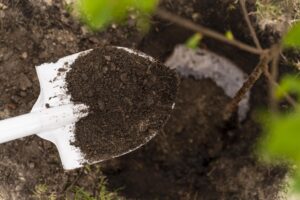Soils are made in part of disintegrated plant matter. This means they contain a lot of carbon that these plants take from the atmosphere while alive. Especially in the colder climates where decomposition is slow, soils can sequester this carbon for a long time.
Soil carbon sequestration is a nature-based solution using plants’ natural photosynthesis process to remove CO2 from the atmosphere and safely save it in the soil and plant roots. Sustainable agriculture projects can help increase the amount of carbon stored by plants. These projects utilize conservation practices, including no- or low-tillage, livestock integration (manure/grazing), cover crops, reduced fertilizer usage, no post-harvest root removal and increased plant diversity.
Soil Carbon Sequestration
Soil carbon sequestration is a natural process in which carbon dioxide is removed from the atmosphere and stored in the soil carbon pool. This process is fundamentally mediated by plants through photosynthesis, with carbon stored as SOC. In arid and semi-arid climates, soil carbon sequestration can also occur by converting CO2 from the air in soil into inorganic forms like secondary carbonates; however, the extent of inorganic carbon formation is comparatively low.
Since the industrial revolution, converting natural ecosystems to agricultural use has depleted SOC levels, releasing 50 to 100 GT of carbon from the soil into the atmosphere. This is the combined result of the reductions in the number of plant roots and debris returned to the earth, increased soil tillage decomposition, and soil erosion. Depletion of soil organic carbon stocks has created a soil carbon deficit that represents an opportunity to store carbon in soil through a variety of land management approaches. However, various factors impact potential soil carbon change in the future, including climatic controls, historical land use patterns, current land management strategies, and topographic heterogeneity.

How does soil carbon sequestration work?
The science behind soil carbon sequestration in agriculture offers a snapshot of the constant dialogue between the atmosphere, plants, and soils. It starts with photosynthesis—and continues in exchanges between plant roots, animals, and microbes living within the ground. Implementing regenerative practices that support soil microbial communities promotes active carbon cycling, thereby accumulating soil organic matter long-term, particularly in deeper soil layers. This persistence ultimately allows farmers to get paid for the carbon in their soil and supporters to receive high-quality credits through various carbon programs.
Persistent forms of carbon can be produced in soils, and this cycling process can be enhanced by:
• Bringing high-quality inputs to the land that support and somewhat diminish efficient microbial activity
• Reducing disturbances (like tillage, which digs up the topsoil) to preserve the biological, physical, and chemical processes already taking place
• The sun provides an endlessly renewable energy source for plants to perform photosynthesis.
• Plants capture carbon dioxide from the atmosphere, tossing aside the two oxygen molecules and keeping the carbon to build up their leaves, stems, and roots.
• Plants secrete some of their carbon reserves from their roots in nutritious offerings known as “exudates,” or simple sugars, proteins, amino acids, organic acids and other essential regulators for the microbial community living in the soil.
• Worms ingest a combination of organic materials (plant residue) and inorganic materials (soil); once that material passes through their guts, it gets excreted as soil “casts.” These soil casts, composed of many small micro aggregates, are bound together in a more decisive way that helps make robust soil aggregates that physically protect newly added surface plant material from decomposition.
• Carbon is moved more profoundly within the soil layers and transformed into more stable forms over time in a continuous cycle of microbial consumption and transformation of plant-derived carbon. Some carbon, usually simple sugars or other small biomolecules, dissolves out of crop residues. If the dissolved carbon comes into contact with bacteria or fungi, the microbes can use that as energy to grow bigger. Because microbes are close to the mineral soil, when they die, the carbon in their bodies joins with these mineral surfaces. Over time, this conversion of dissolved carbon into microbial tissue increases the size of the microbial pool. When they die, much of that microbial carbon cycles through the soil – eventually increasing soil carbon stocks.
In conclusion
Soil Organic Carbon or SOC is a vital component of soil with essential effects on the functioning of terrestrial ecosystems. Storage of soil organic carbon results from interactions among the ecological processes of photosynthesis, decomposition, and soil respiration. Over the last 150 years, human activities have led to massive alterations in these processes and, consequently, led to the depletion of SOC and the worsening of global climate change. But these human activities now also provide an opportunity for sequestering carbon back into the soil. Future warming and elevated carbon dioxide, patterns of past land use, land management strategies, and the physical heterogeneity of surface lands are expected to produce complex designs of SOC capacity in soil. Ultimately, scientists say carbon sequestration, like other negative emissions technologies, can also help fight climate change but cannot take carbon out of the atmosphere as fast as we are currently adding it. These efforts to store carbon must be coupled with drastic cuts in greenhouse gas emissions to stop global warming.
If you are looking for help regarding soil carbon measurement, our experts at SoilOptix® can help. Visit https://soiloptix.com/ for a detailed consultation.
